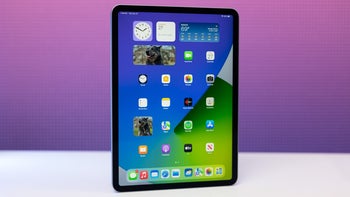OnePlus Pad 2 vs OnePlus Pad: Baby steps again...

Intro
Sometimes it's difficult to justify a new smartphone or tablet model, especially in 2024. Nowadays, innovation consists of a new processor and, if you're lucky, new camera hardware (but most of the time, it's just software algorithms and AI).
The case with the OnePlus Pad 2 might be different, though (or not). OnePlus has changed some things to bring this second iteration to the market and make it competitive. And largely, the company has succeeded in doing so. The OnePlus Pad 2 offers some nice upgrades over the previous model, but can they justify a new device with the number two in its name?
Let's compare the two and find out! Bear in mind, though, that we couldn't get the original OnePlus Pad and review it, so this comparison will be more on the theoretical side of things. Nevertheless, it could offer some perspective and a useful angle.
The case with the OnePlus Pad 2 might be different, though (or not). OnePlus has changed some things to bring this second iteration to the market and make it competitive. And largely, the company has succeeded in doing so. The OnePlus Pad 2 offers some nice upgrades over the previous model, but can they justify a new device with the number two in its name?
OnePlus Pad 2 vs OnePlus Pad differences explained:
| OnePlus Pad 2 | OnePlus Pad |
|---|---|
| Larger and heavier | A more compact and lightweight tablet |
| Larger 12.1-inch display, supports a 144 Hz refresh rate | A smaller 11.6-inch screen, slightly few pixels per inch |
| One main camera and one selfie camera | Same camera setup |
| 8GB and 12GB memory options | Memory options are identical |
| Equal native storage (128GB), no microSD card slot | Same storage options, no microSD card slot |
| A big 9510mAh battery | Same battery |
| Same wired charging speed (67W) | 67W wired charging, no wireless charging |
| Newer and faster hardware | Previous generation hardware |
| Slightly more expensive | A bit cheaper |
Table of Contents:
- Design and Display
- Performance and Software
- Camera
- Battery and Charging
- Audio Quality
- Specs
- Which one should you buy?
Also read:
- OnePlus Pad 2 review: The all-rounder
- OnePlus Pad 2 vs Samsung Galaxy Tab S9: It's an Android battle
Design and Display Quality
It's all about that size
It seems that OnePlus decided to alter the size of the second OnePlus Pad and make it larger. The difference is not huge, we're talking about a centimeter by half a centimeter taller and wider, respectively. The design is the same, but it's a good thing. There's a nice aluminum unibody with rounded edges all around. It's nice to hold it in your hand with no hard 90-degree edges to dig into your palm.
The weight has also changed from the original OnePlus Pad, the new version is 32 grams heavier, which is understandable given the bigger size of the device. We quite liked the Halo Green color of the original OnePlus Pad, and the new model is now available in Nimbus Gray, which is a bit boring to be honest, but gray is always in fashion when it comes to electronics.
The weight has also changed from the original OnePlus Pad, the new version is 32 grams heavier, which is understandable given the bigger size of the device. We quite liked the Halo Green color of the original OnePlus Pad, and the new model is now available in Nimbus Gray, which is a bit boring to be honest, but gray is always in fashion when it comes to electronics.
Display Measurements:
Moving to the display panels of both devices, we find small differences here. Both rely on IPS LCD panels, which are backlit, no fancy OLED tech to be found. This has pros and cons, but the new OnePlus Pad 2 is brighter, with 600 nits of typical and 900 nits of peak brightness. We measured 786 nits of brightness on the OnePlus Pad 2.
There's a slight difference in resolution and pixel density between these two. The original OnePlus Pad comes with a resolution of 2000 x 2800 pixels, resulting in around 296 ppi density, while the successor boasts 2120 x 3000 pixels and a pixel density of 303 ppi.
The refresh rate is the same on both devices, they can go up to 144 Hz, and also support a wide range of refresh rates, from as low as 30 Hz to 120 and 144 Hz.
Neither of these have a fingerprint reader, they both rely on PIN protection and a face ID, but the latter uses a simple 8MP selfie camera, so it's not very secure.
There's a slight difference in resolution and pixel density between these two. The original OnePlus Pad comes with a resolution of 2000 x 2800 pixels, resulting in around 296 ppi density, while the successor boasts 2120 x 3000 pixels and a pixel density of 303 ppi.
Neither of these have a fingerprint reader, they both rely on PIN protection and a face ID, but the latter uses a simple 8MP selfie camera, so it's not very secure.
Performance and Software
A generational leap with a twist
Probably the biggest change and upgrade OnePlus made lies in the chipset. The original OnePlus Pad ships with Dimensity 9000 silicon, while the successor uses Qualcomm's latest and greatest Snapdragon 8 Gen 3.
On paper, this should manifest in a big difference in synthetic benchmark scores, but scores are closer than one might expect. The OnePlus Pad 2 scored 931 and 4585 in Geekbench single and multi-core, respectively, while the original OnePlus Pad and its Dimensity 9000 chipset managed around 800 and 3500 in both tests, which is much closer than expected.
The RAM and storage situation is identical, both models have 8/128GB and 12/256GB versions, so there is no differentiating factor here.
On paper, this should manifest in a big difference in synthetic benchmark scores, but scores are closer than one might expect. The OnePlus Pad 2 scored 931 and 4585 in Geekbench single and multi-core, respectively, while the original OnePlus Pad and its Dimensity 9000 chipset managed around 800 and 3500 in both tests, which is much closer than expected.
The RAM and storage situation is identical, both models have 8/128GB and 12/256GB versions, so there is no differentiating factor here.
Performance Benchmarks:
When it comes to software, the original OnePlus Pad first launched running Android 13 with Oxygen OS 13.1 on top, but it is upgradable to Android 14 and Oxygen 14.1. This upgrade brings a slew of AI features, such as AI Speak and AI Summary, the ability to transcribe text, and a writing assist feature.
The OnePlus Pad 2 comes with all the aforementioned software tricks out of the box, it runs on Android 14 and Oxygen OS 14, so in the end, you don't have much differentiation here as well. In terms of longevity, though, there's a one year gap in software support, so the OnePlus Pad 2 will last longer.
To be specific, there are three major OS updates coming to the OnePlus Pad 2, plus one additional year of software security patches. This means the tablet will be good to go until 2027, which is not bad for a tablet device, but also not nearly as robust as the seven year software support Google and Samsung are currently offering.
The OnePlus Pad 2 comes with all the aforementioned software tricks out of the box, it runs on Android 14 and Oxygen OS 14, so in the end, you don't have much differentiation here as well. In terms of longevity, though, there's a one year gap in software support, so the OnePlus Pad 2 will last longer.
Camera
Identical
You don't buy a tablet for its main camera, but still, it's nice to have one. That's the exact number of cameras on the back of both of those. One. It's a 13 MP sensor with autofocus and 4K recording capabilities on both. Actually, the camera hardware is absolutely identical, and as we don't have samples from the original OnePlus Pad, we're including the ones we snapped with the newer mode for you to get a basic idea of what to expect.
OnePlus Pad 2 main and selfie camera samples:
Battery Life and Charging
It's the same, still great, though
The battery and charging specs are the same, nothing has changed between the generations for the OnePlus Pad in that area. Both tables feature a 9,510mAh battery and can charge it with up to 67W of power. This translates into pretty fast charging times and also offers great battery life all around.
We don't have benchmarks for the original OnePlus Pad, but we're including the ones we did on the OnePlus Pad 2. There might be some slight fluctuations attributed to the different chipsets and screen sizes, but all in all, this is what you can expect from both tablets.
Audio Quality and Haptics
Another area where the OnePlus Pad 2 excels is the audio quality. The speakers inside the new model have been upgraded, and their sheer number has increased. The original OnePlus Pad features four stereo speakers, while the new model comes with six of them.
Unsurprisingly, the OnePlus Pad 2 sounds amazing, Bluetooth-speaker-level amazing. The bass is rich and detailed, the audio is loud, and there are no harmonic distortions even at max level. This is one of the few hardware upgrades between these two models, and one that makes a difference.
Unsurprisingly, the OnePlus Pad 2 sounds amazing, Bluetooth-speaker-level amazing. The bass is rich and detailed, the audio is loud, and there are no harmonic distortions even at max level. This is one of the few hardware upgrades between these two models, and one that makes a difference.
Specs Comparison
Here's a quick specs comparison between these two. For a more detailed one, you should check out our OnePlus Pad 2 vs OnePlus Pad specs comparison on PhoneArena.
| Specs | OnePlus Pad 2 | OnePlus Pad |
|---|---|---|
| Dimensions | 268.7 x 195.1 x 6.5 mm | 258 x 189.4 x 6.5 mm |
| Weight | 584 g | 552 g |
| Screen | 12.1-inche LCD IPS 144Hz 2120 x 3000 pixels 600 nits typical | 11.6-inch LCD IPS 144Hz 2000 x 2800 pixels 500 nits typical |
| Processor | Snapdragon 8 Gen 3 | Mediatek Dimensity 9000 |
| RAM, Storage and Price | 128GB 8GB RAM 256GB 12GB RAM ($550) | 128GB 8GB RAM 256GB 12GB RAM ($500) |
| Cameras | 13 MP, f/2.2, 23mm (wide) 8MP front | 13 MP, f/2.2, 23mm (wide) 8 MP front |
| Battery Size | 9,510 mAh | 9,510 mAh |
| Charging Speeds | 67W wired - | 67W wired - |
Which one should you buy?
There's an easy answer to this question. If you don't have the original OnePlus Pad and plan on bying a tablet, the second iteration is better and deserves your attention. If you already own the original OnePlus Pad, there's little to no reason to upgrade, these two devices are more similar than different and you'll get more or less the same experience from the original model.
Things are a bit more complicated if we throw a Galaxy Tab into the equation. You can check our OnePlus Pad 2 vs Galaxy Tab S9 comparison for more details. But overall, the OnePlus Pad 2 offers a pretty decent package for the price and can compete with other flagship tablets in its price range. Check out the full OnePlus Pad 2 review as well.
Things are a bit more complicated if we throw a Galaxy Tab into the equation. You can check our OnePlus Pad 2 vs Galaxy Tab S9 comparison for more details. But overall, the OnePlus Pad 2 offers a pretty decent package for the price and can compete with other flagship tablets in its price range. Check out the full OnePlus Pad 2 review as well.


















Things that are NOT allowed: